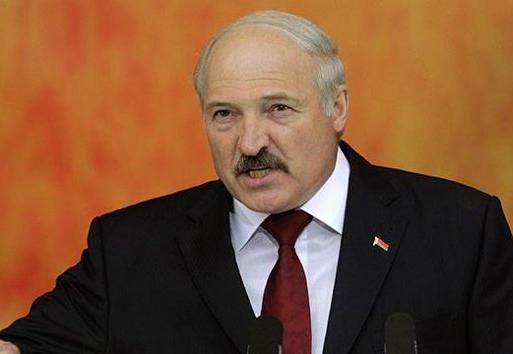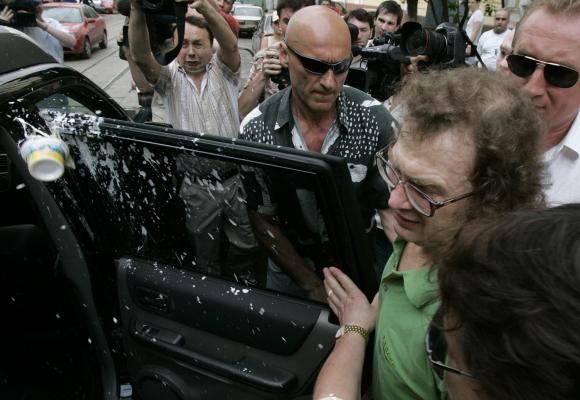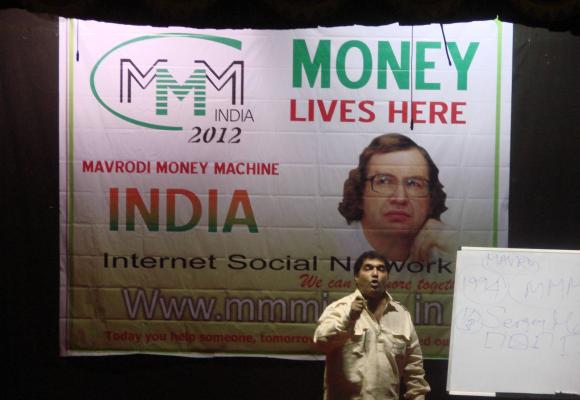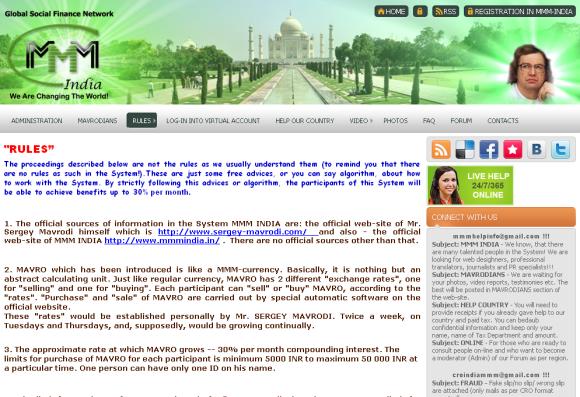Photographs: Maxim Shemetov/Reuters N Sundaresha Subramanian
When Sergey Mavrodi said he was launching a new scheme in 2011, many people took it as a PR stunt aimed at capitalising on the impending release of PiraMMMida, a Russian language movie directed by Eldar Salavatov, starring Alexei Serebryakov.
While the name of the protagonist, played by Serebryakov, is Momantov, the story more closely follows the rise and fall of Mavrodi in 1990s post-communist Russia.
The screenplay itself is based on a short story called 'Piramida', or pyramid in Russian, written by Mavrodi himself.
The trailer of the movie shows a foreigner offering $50 billion to use the MMM brand name and its network. Momantov says, "Russia is not up for sale."
Mavrodi is not a distant villain, like those sinister men in James Bond movies. When he launched his MMM2011 - a pyramidal money-making scheme - he also started MMM India.
MMM2011 spread like wild-fire. From North American gamblers to Indonesian housewives and Indian salesmen, all got hooked.
At the last count, Mavrodi's websites claimed to have over 35 million people in the network.
...
Man who wants to destroy world's financial system
Image: Belarussian President Alexander Lukashenko.Photographs: Reuters
The Russian even had the audacity to offer his scheme to the Belarussian President as a solution to his country's inflation problems.
In India, adherents in the countryside of Maharashtra, Gujarat and Punjab are growing by the day. There are plans to take the network to other states.
Regulators in Russia and the former CIS countries are floundering: though the Russian Federal Anti-monopoly Service (FAS) declared the scheme a "pyramid" in January 2011, it could not find any legal provision to declare it illegal. Indian regulators are likely to face a similar dilemma about MMM India.
Once you register with MMM India, you can commit to "help" someone with a certain amount, for which you get help in return of a higher amount.
The returns are in Mavros, virtual currency whose selling and buying rates are controlled, apparently by Mavrodi himself.
Mavrodi, 57, who launched his first MMM scheme in 1988, has claimed in video posts on his website that he built the financial scheme to destroy the global financial system, which is created and dominated by people who can print currencies.
"My goal is a financial apocalypse, a destruction of the global financial system," he had said in March 2012, just hours before he was arrested for unknown charges.
...
Man who wants to destroy world's financial system
Image: Sergey Mavrodi.Photographs: Grigory Dukor/Reuters
While there have been attempts to book Mavrodi under a special dispensation and bar him from any finance related activity, Mavrodi claims this is victimisation by bureaucrats.
He is even reported to have written open letters to Russian President Vladimir Putin. In July 2012, Putin was quoted in the Russian media as saying that people should be protected from swindlers like Mavrodi.
"As for whether it is time for him [Mavrodi] again to go to prison, this should be established by law enforcement agencies first," Putin added.
Arrest and jail terms are not new to Mavrodi. Following the fall of communism, Mavrodi's investment firm had imploded after attracting investments from about five million Russians, promising them foreign holidays and 2,000 per cent returns, according to a 1994 Time report.
Mavrodi had immunity from prosecution, as he was a member of the Duma (Parliament), until that immunity was nullified in October 1995.
In December 1997, Mavrodi declared MMM bankrupt. He managed to escape arrest till 2003 as gaps in Russian financial laws left authorities clueless about finding the right rule to charge him.
...
Man who wants to destroy world's financial system
Image: Sour cream is thrown at Sergey Mavrodi (in green shirt), former head of a collapsed 1990s investment scheme, as he gets into a car after leaving prison in Moscow.Photographs: Alexander Natruskin/Reuters
Eventually, he was convicted for holding a fake passport and for tax-related offences. But he was a free man by May 2007.
It did not take too long for him to devise a scheme to harness the powers of the Internet so that national boundaries did not hinder him.
Mavrodi and his preachers take pains to explain how every conceivable financial institution in the world is either a pyramid or part of one.
Banks are the basic pyramids, explains Dinesh Kotian, Mumbai-based campaigner for MMMIndia, to his rapt audience in an auditorium.
He points out how banks take deposits from, say Satish, cheaply at 4 per cent and lend it to, say Dinesh, at 15 per cent per annum, making an 11 per cent profit in the process.
Kotian's speech, of course, is just a translation of a Mavrodi video, several of which are floating around on the web. In some, he is seen being interviewed by reporters; in others he talks through a webcam.
His message is: the world's financial system is a giant pyramid and on top of it is the US Federal Reserve. He calls for people to get into the MMM network and help bring on a financial apocalypse.
...
Man who wants to destroy world's financial system
Image: MMMIndia presentation at NagpurPhotographs: Courtesy, MMMIndia
"Together we can do a lot," he concludes his speeches. In Russian, the first letters of these words form the initials MMM.
Kotian and other speakers do not try to hide Mavrodi's troubled past; they make a virtue out of it. They portray him as a mathematical genius who once had one-third of all rouble currency notes in Russia in his custody.
They tell of how the establishment was scared of him and raided places where he had stored this money. By robbing him of this money, they created a panic and forced his scheme to collapse in the 1990s, they claim.
To reassure them, they say that this time around, Mavrodi has devised a scheme in such a way that the cash is not stored in one place. It remains in the accounts of individual participants in what he calls a global mutual aid fund.
Participants in the MMM system are divided into thousands, hundreds, and tens, and each cell has a manager called, respectively, a thousand's manager, hundred's manager, and ten's manager.
These managers permit the entry of new participants. An administrator at the country level monitors the 'help' giving and seeking.
Alexei Muratov, Mavrodi's India representative, dressed in a black suit and a red tie, guns off a string of Russian sentence at a packed stage in rural Maharashtra.
Not one of the listeners understands a word. But they all know what he is talking about: "A revolutionary idea".
Click NEXT to read how the scheme works...
Man who wants to destroy world's financial system
Image: Screenshot of MMMIndia's website.Here's How the Scheme Works
- When enrolling with MMM, you are given a login ID and a password
- You are required to have a bank account dedicated to the scheme
- A person can commit 'help' between Rs 5,000 and Rs 50,000
- Administrator uses software to match the 'help' with seeker and giver
- When you give 'help', you earn an equivalent amount in Mavro. Mavro has two exchange rates for selling and buying.
- The rates prevailing at various times are determined by Sergey Mavrodi
- Mavro is said to grow at 100 per cent monthly at compound interest








article